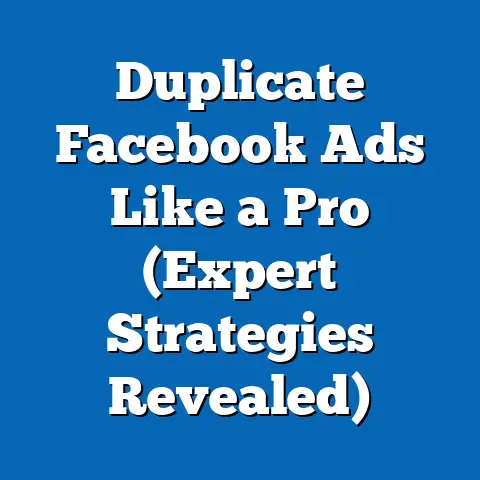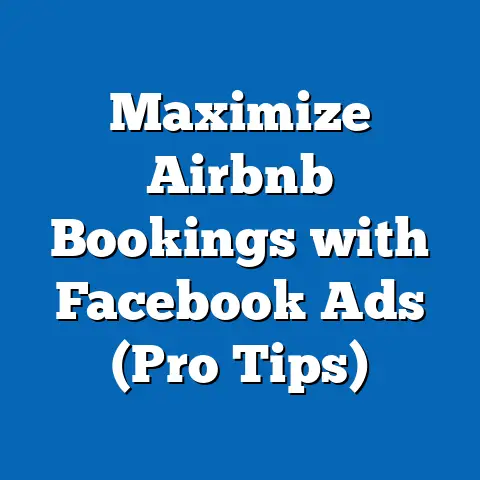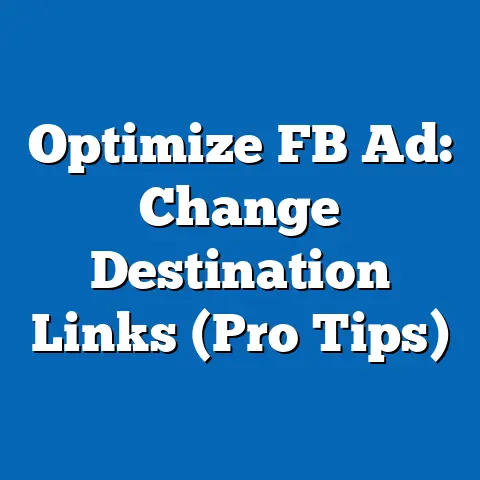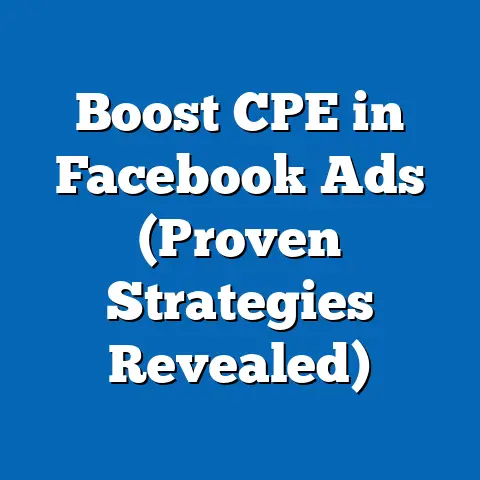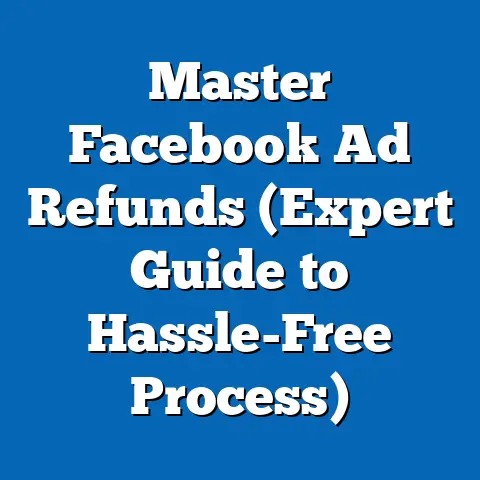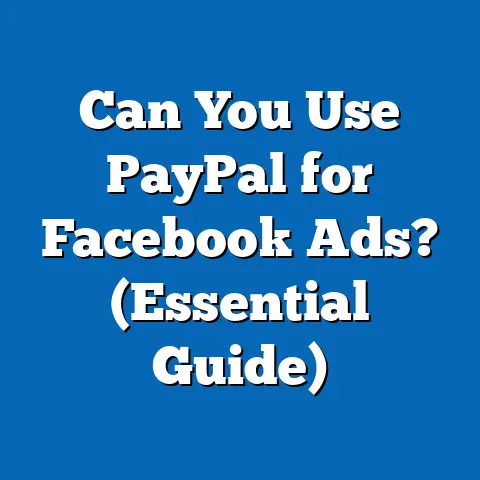Master Effective Facebook Ads Design (Proven Strategies)
Facebook. It’s more than just a social network; it’s a powerhouse for advertising. From the smallest startup hustling to get its name out there, to the largest corporation launching a new product, Facebook offers a platform to connect with a truly diverse audience. I’ve seen firsthand how its unique capabilities – hyper-targeting based on demographics, interests, behaviors, and more – make it an indispensable tool for marketers.
But let’s be real, navigating the world of Facebook ads isn’t always smooth sailing. The platform is constantly evolving, with algorithms shifting and user preferences changing. This dynamic nature presents both challenges and incredible opportunities. That’s why mastering effective ad design is absolutely crucial. It’s the key to cutting through the noise, capturing attention, and ultimately, achieving your advertising goals. In this guide, I’ll walk you through proven strategies that I’ve used and seen work, to help you create Facebook ads that not only look good but also deliver real results. Let’s dive in!
Understanding Facebook’s Ad Formats
Facebook offers a buffet of ad formats, each designed to cater to different objectives and creative approaches. Knowing the strengths and weaknesses of each is paramount. Here’s a rundown:
-
Image Ads: These are your bread and butter. A single, compelling image paired with concise copy. They’re simple, effective for showcasing products, and great for driving traffic to your website. I’ve found that high-quality, visually appealing images are key here. Think professional photography or eye-catching graphics.
-
Video Ads: Video is king! These ads can tell a story, demonstrate a product in action, or simply capture attention with movement and sound. They’re fantastic for building brand awareness and driving engagement. I’ve personally seen video ads drastically increase click-through rates compared to static images.
-
Carousel Ads: Showcase multiple products or features in a single ad unit. Users can swipe through different images or videos, each with its own headline, description, and link. I’ve used carousel ads to highlight different aspects of a service or to tell a story sequentially, and the results have been impressive.
-
Slideshow Ads: Similar to video ads, but created using a series of images or videos. They’re a great alternative for marketers who don’t have the resources to create high-quality video content. I’ve found them particularly effective for showcasing before-and-after transformations.
-
Collection Ads: Designed for e-commerce businesses, these ads feature a main video or image above a selection of products. Users can click on a product to view it directly on your website. This is a fantastic format for driving sales and showcasing your product catalog. I remember working with a clothing brand that saw a significant boost in sales after implementing collection ads.
Image Ads: These are your bread and butter. A single, compelling image paired with concise copy. They’re simple, effective for showcasing products, and great for driving traffic to your website. I’ve found that high-quality, visually appealing images are key here. Think professional photography or eye-catching graphics.
Video Ads: Video is king! These ads can tell a story, demonstrate a product in action, or simply capture attention with movement and sound. They’re fantastic for building brand awareness and driving engagement. I’ve personally seen video ads drastically increase click-through rates compared to static images.
Carousel Ads: Showcase multiple products or features in a single ad unit. Users can swipe through different images or videos, each with its own headline, description, and link. I’ve used carousel ads to highlight different aspects of a service or to tell a story sequentially, and the results have been impressive.
Slideshow Ads: Similar to video ads, but created using a series of images or videos. They’re a great alternative for marketers who don’t have the resources to create high-quality video content. I’ve found them particularly effective for showcasing before-and-after transformations.
Collection Ads: Designed for e-commerce businesses, these ads feature a main video or image above a selection of products. Users can click on a product to view it directly on your website. This is a fantastic format for driving sales and showcasing your product catalog. I remember working with a clothing brand that saw a significant boost in sales after implementing collection ads.
The takeaway: Choosing the right format depends on your campaign objectives, target audience, and creative resources. Experiment with different formats to see what works best for your brand. Don’t be afraid to think outside the box and try something new!
The Importance of Visual Elements
In the fast-paced world of social media, visuals are your first and often only chance to grab someone’s attention. A stunning image or captivating video can stop a user mid-scroll and draw them into your message. But it’s not just about having a pretty picture; it’s about understanding the principles of effective design and how they apply to Facebook ads.
-
Color Theory: Colors evoke emotions and associations. Understanding color psychology can help you choose colors that resonate with your target audience and reinforce your brand identity. For example, blue often conveys trust and stability, while red can evoke excitement and urgency. I once worked on a campaign for a sustainable energy company and we used a lot of green and blue tones to emphasize their eco-friendly values.
-
Typography: The fonts you use can have a significant impact on readability and brand perception. Choose fonts that are easy to read and that align with your brand’s personality. I’ve seen ads fail simply because the font was too small or too difficult to decipher.
-
Composition: The way you arrange elements within your ad can influence how users perceive your message. Use the rule of thirds, leading lines, and other composition techniques to create visually balanced and engaging ads. I often use negative space to draw attention to the focal point of my ads.
-
Brand Consistency: Your ads should be consistent with your overall brand identity. Use the same colors, fonts, and imagery that you use on your website and other marketing materials. This helps to build brand recognition and trust. I always create a style guide for my clients to ensure consistency across all their marketing efforts.
Color Theory: Colors evoke emotions and associations. Understanding color psychology can help you choose colors that resonate with your target audience and reinforce your brand identity. For example, blue often conveys trust and stability, while red can evoke excitement and urgency. I once worked on a campaign for a sustainable energy company and we used a lot of green and blue tones to emphasize their eco-friendly values.
Typography: The fonts you use can have a significant impact on readability and brand perception. Choose fonts that are easy to read and that align with your brand’s personality. I’ve seen ads fail simply because the font was too small or too difficult to decipher.
Composition: The way you arrange elements within your ad can influence how users perceive your message. Use the rule of thirds, leading lines, and other composition techniques to create visually balanced and engaging ads. I often use negative space to draw attention to the focal point of my ads.
Brand Consistency: Your ads should be consistent with your overall brand identity. Use the same colors, fonts, and imagery that you use on your website and other marketing materials. This helps to build brand recognition and trust. I always create a style guide for my clients to ensure consistency across all their marketing efforts.
Real-World Example: I recall a campaign for a local coffee shop. We used high-quality photos of their signature drinks, shot in a warm, inviting light. The text was minimal, focusing on the sensory experience of enjoying their coffee. The result? A significant increase in foot traffic and online orders.
The takeaway: Invest time and effort in creating visually stunning ads that capture attention and reinforce your brand identity. Don’t underestimate the power of a well-designed visual!
Crafting Compelling Ad Copy
While visuals grab attention, ad copy seals the deal. It’s the voice of your brand, the message that resonates with your audience, and the call to action that drives them to take the next step. Effective ad copy is concise, impactful, and relevant to your target audience.
-
Headlines: Your headline is the first thing people read. It should be attention-grabbing, concise, and clearly communicate the value proposition of your product or service. I often use questions or intriguing statements to pique curiosity.
-
Body Text: Your body text should provide more detail about your product or service, highlighting its key benefits and features. Use clear, concise language and avoid jargon. I always focus on the “what’s in it for me” aspect for the user.
-
Calls to Action (CTAs): Your CTA tells users what you want them to do next. Use strong, action-oriented language and make it clear what they’ll get by clicking on your ad. Examples include “Shop Now,” “Learn More,” “Sign Up,” and “Get Started.” I always test different CTAs to see which performs best.
-
Emotional Appeal: Connect with your audience on an emotional level. Tell a story, share a testimonial, or highlight the positive impact your product or service has on people’s lives. I’ve found that ads that evoke emotions are much more likely to be shared and remembered.
Headlines: Your headline is the first thing people read. It should be attention-grabbing, concise, and clearly communicate the value proposition of your product or service. I often use questions or intriguing statements to pique curiosity.
Body Text: Your body text should provide more detail about your product or service, highlighting its key benefits and features. Use clear, concise language and avoid jargon. I always focus on the “what’s in it for me” aspect for the user.
Calls to Action (CTAs): Your CTA tells users what you want them to do next. Use strong, action-oriented language and make it clear what they’ll get by clicking on your ad. Examples include “Shop Now,” “Learn More,” “Sign Up,” and “Get Started.” I always test different CTAs to see which performs best.
Emotional Appeal: Connect with your audience on an emotional level. Tell a story, share a testimonial, or highlight the positive impact your product or service has on people’s lives. I’ve found that ads that evoke emotions are much more likely to be shared and remembered.
Real-World Example: I worked with a non-profit organization that was running a fundraising campaign. Instead of simply asking for donations, we told the story of a person whose life had been changed by their services. The ad copy was heartfelt and authentic, and it resonated deeply with the target audience. The result was a significant increase in donations.
The takeaway: Write ad copy that is clear, concise, and compelling. Focus on the benefits of your product or service and connect with your audience on an emotional level. And don’t forget to include a strong call to action!
Targeting and Audience Segmentation
Imagine shouting into a crowded room, hoping someone will hear your message. That’s what untargeted advertising feels like. Facebook’s powerful targeting options allow you to laser-focus your ads on the people who are most likely to be interested in your product or service. This not only saves you money but also increases the effectiveness of your campaigns.
-
Custom Audiences: Upload your existing customer data (email addresses, phone numbers, etc.) to create a custom audience. You can then target these users with specific ads or create a Lookalike Audience based on their characteristics. I’ve used Custom Audiences to re-engage existing customers with special offers or to promote new products.
-
Lookalike Audiences: Facebook will analyze your existing customer data and identify users who share similar characteristics. This is a great way to reach new customers who are likely to be interested in your product or service. I’ve found that Lookalike Audiences often outperform interest-based targeting.
-
Interest-Based Targeting: Target users based on their interests, hobbies, and demographics. This is a good option if you don’t have existing customer data or if you’re trying to reach a broad audience. I always research my target audience thoroughly to identify relevant interests and demographics.
Custom Audiences: Upload your existing customer data (email addresses, phone numbers, etc.) to create a custom audience. You can then target these users with specific ads or create a Lookalike Audience based on their characteristics. I’ve used Custom Audiences to re-engage existing customers with special offers or to promote new products.
Lookalike Audiences: Facebook will analyze your existing customer data and identify users who share similar characteristics. This is a great way to reach new customers who are likely to be interested in your product or service. I’ve found that Lookalike Audiences often outperform interest-based targeting.
Interest-Based Targeting: Target users based on their interests, hobbies, and demographics. This is a good option if you don’t have existing customer data or if you’re trying to reach a broad audience. I always research my target audience thoroughly to identify relevant interests and demographics.
Real-World Example: I worked with a local bookstore that wanted to promote their new book club. We used interest-based targeting to reach users who were interested in books, literature, and reading. We also targeted users who had liked the pages of other bookstores or authors. The result was a significant increase in book club sign-ups.
The takeaway: Targeting the right audience is crucial for the success of your Facebook ads. Take the time to research your target audience and use Facebook’s targeting options to reach them effectively.
A/B Testing and Optimization
You’ve created a great ad, targeted the right audience, and launched your campaign. But the work doesn’t stop there! A/B testing is the process of comparing two versions of an ad to see which performs better. It’s an essential tool for optimizing your Facebook ad performance and maximizing your ROI.
-
What to Test: You can test almost any element of your ad, including visuals, headlines, body text, CTAs, and audience targeting. I recommend testing one element at a time to isolate the impact of each change.
-
How to Set Up A/B Tests: Facebook provides built-in A/B testing tools that make it easy to create and run tests. Simply create two versions of your ad, specify the element you want to test, and set a budget and duration for the test.
-
Analyzing Results: Once the test is complete, analyze the results to see which version performed better. Pay attention to metrics such as click-through rate, conversion rate, and cost per acquisition.
What to Test: You can test almost any element of your ad, including visuals, headlines, body text, CTAs, and audience targeting. I recommend testing one element at a time to isolate the impact of each change.
How to Set Up A/B Tests: Facebook provides built-in A/B testing tools that make it easy to create and run tests. Simply create two versions of your ad, specify the element you want to test, and set a budget and duration for the test.
Analyzing Results: Once the test is complete, analyze the results to see which version performed better. Pay attention to metrics such as click-through rate, conversion rate, and cost per acquisition.
Real-World Example: I worked with an e-commerce business that was running a campaign to promote their new line of clothing. We ran an A/B test to compare two different headlines. One headline focused on the quality of the clothing, while the other focused on the style. The results showed that the headline that focused on style performed significantly better. We then used this information to optimize the rest of the campaign.
The takeaway: A/B testing is an ongoing process. Continuously test different elements of your ads to identify what works best for your target audience. Don’t be afraid to experiment and try new things!
Staying Updated with Facebook Ad Trends
The world of Facebook advertising is constantly evolving. New features are introduced, algorithms are updated, and consumer behaviors change. Staying informed about the latest trends and best practices is crucial for maintaining a competitive edge.
-
Emerging Technologies: Keep an eye on emerging technologies such as augmented reality (AR) ads and the integration of e-commerce features. These technologies offer new and exciting ways to engage with your audience and drive conversions.
-
Platform Updates: Facebook regularly updates its advertising platform, introducing new features and changing existing ones. Stay informed about these updates and adapt your strategies accordingly.
-
Consumer Behaviors: Consumer behaviors are constantly changing. Pay attention to how your target audience is using Facebook and adapt your advertising strategies to meet their needs.
Emerging Technologies: Keep an eye on emerging technologies such as augmented reality (AR) ads and the integration of e-commerce features. These technologies offer new and exciting ways to engage with your audience and drive conversions.
Platform Updates: Facebook regularly updates its advertising platform, introducing new features and changing existing ones. Stay informed about these updates and adapt your strategies accordingly.
Consumer Behaviors: Consumer behaviors are constantly changing. Pay attention to how your target audience is using Facebook and adapt your advertising strategies to meet their needs.
Resources for Staying Updated:
- Facebook Business Help Center: The official resource for all things Facebook advertising.
- Industry Blogs: Follow industry blogs and publications to stay informed about the latest trends and best practices.
- Online Communities: Join online communities and forums to connect with other marketers and share insights.
The takeaway: Staying updated with Facebook ad trends is an ongoing process. Make it a habit to regularly check industry blogs, attend webinars, and experiment with new features. By staying ahead of the curve, you can ensure that your Facebook ads are always performing at their best.
Conclusion
Mastering effective Facebook ad design is a journey, not a destination. It requires versatility, creativity, and a data-driven approach. By understanding the different ad formats, focusing on visual elements, crafting compelling ad copy, targeting the right audience, A/B testing your ads, and staying updated with the latest trends, you can create Facebook ads that not only look good but also deliver real results.
I encourage you to implement the proven strategies outlined in this article and take your Facebook ad campaigns to the next level. Don’t be afraid to experiment, test new ideas, and learn from your mistakes. And remember, the most important thing is to focus on providing value to your audience and building meaningful connections. Now, go out there and create some amazing Facebook ads!

